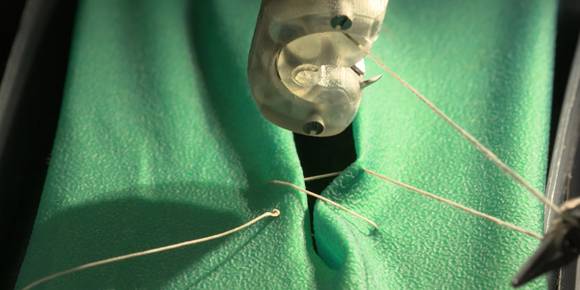
[ihc-hide-content ihc_mb_type=”show” ihc_mb_who=”reg” ihc_mb_template=”3″ ]
[vc_row][vc_column][vc_column_text]
Credits: www.metal-am.com
UK-based medical research company Sutrue has successfully developed and patented two new automated suturing devices featuring metal additively manufactured components. The two devices – a handheld suturing device and an endoscopic/robotic suturing device – are the product of more than eight years of development between Sutrue and Richard Trimlett (Cardiothoracic Surgeon and Head of Mechanical Support at the Royal Brompton Hospital), as well as a number of other medical professionals including Professor John Pepper OBE, Professor in Cardiothoracic Surgery at the National Heart and Lung Institute.
Medical stitching by hand can sometimes be problematic, as it relies on the ability, dexterity, training and alertness of a practitioner. According to Sutrue, its two devices have the potential to transform the manual process of stitching into a far simpler, quicker and more accurate automated process, thus reducing the margin for human error. There have been over 10,000 patent attempts to produce a device that sutures wounds, including one in 1908, but Sutrue is said to be the first to successfully achieve it.
Device development
To create its suturing mechanism, the company produced thirty-eight prototypes and designed and tested more than 1,500 parts. The result was a patented automated suturing mechanism with the ability to produce a row of sutures, tie a knot and sew around corners. These capabilities offer significant benefits within medicine and – in the case of the handheld device – even industrial applications.[/vc_column_text][vc_single_image image=”3199″ img_size=”full” add_caption=”yes”][vc_column_text]Sutrue has been working with with Concept Laser, a GE Additive company, for the past three years to additively manufacture the small, detailed parts used in the automated suturing devices on an Mlab Cusing R system. Alex Berry, Sutrue’s Managing Director, stated, “Rapid prototyping has significantly reduced the cost of the creation of the devices, probably by a factor of fifty. It has also shaved years off the time it would have otherwise taken. We’ve taken a ‘create, print, test, tweak, reprint’ approach to solving the problem. We even coined our own term for the working process and called it ‘Multi-typing’, which is the ability to loosely design the same component in three or four different ways, have them printed within a few hours and then test and learn from each prototype. This approach has been instrumental in allowing a small start-up company like ours to maximise our output in terms of creativity and problem solving.”
Stephan Zeidler, Business Development Manager for the Medical Sector at Concept Laser, stated, “Once designed by Sutrue, the structurally superior parts were printed by our team before Sutrue assembled them into numerous medical prototypes – sometimes straight from our printer with minimal post-processing. This in turn saved considerable time and cost and has resulted in the completion of a series of fully-functioning medical prototypes. Sutrue’s success in having achieved this is a fantastic example of what is possible with our DMLM machines and AM technology. We are delighted that both devices are now mechanically sound and are ready for testing within medical industry.”
Benefits and applications
Richard Trimlett believes that the robotic/endoscopic suturing device could be influential to the future of robotic surgery, significantly reducing the number of open operations undertaken in the future. “The majority of operations we’re doing today are still open and that’s not because the patient wants them open, it’s because of the limitations of the technology,” he explained. “There are many improvements to technology that we need to get to the point where we can do everything as a keyhole operation, and I see [Sutrue’s device] as one of them.”
As well as reducing the number of open surgeries performed, the benefits offered by using this device instead of forceps include increased suturing speed (an experienced endoscopic surgeon can take up to twenty-five seconds per stitch, whereas the device takes 1/3 of a second), increased access to hard-to-reach places using the articulation of the device, increased accuracy and reduction in human error.
The handheld suturing device is expected to benefit inexperienced medical staff when closing wounds, as well as having applications veterinary practice, dentistry, in extreme environments such as field hospitals and in space, and potentially in manufacturing and the textiles industry. The device also enables use of reduced needle sizes to reduce tissue trauma or scarring, and reduces the risk of needle stick injuries among healthcare practitioners, thus reducing the risk of HIV and Hepatitis B infection.[/vc_column_text][/vc_column][/vc_row]
[/ihc-hide-content]
The LEGO Group has announced the release of its first-ever mass-produced 3D printed component, which…
Boeing has unveiled a groundbreaking 3D-printed solar array substrate that promises to dramatically accelerate satellite…
Apple has unveiled its latest innovations, the ultra-slim iPhone Air and the new Apple Watch…
AM Conclave Middle East 2025, the region’s premier Additive Manufacturing (AM) trade show and conference,…
3D Systems, has announced its financial results for the second quarter of 2025, reporting a…
In a significant advancement for in-space manufacturing, researchers at Leibniz University Hannover, in partnership with…
This website uses cookies.